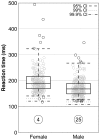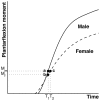On the implications of a sex difference in the reaction times of sprinters at the Beijing Olympics
- PMID: 22039438
- PMCID: PMC3198384
- DOI: 10.1371/journal.pone.0026141
On the implications of a sex difference in the reaction times of sprinters at the Beijing Olympics
Abstract
Elite sprinters offer insights into the fastest whole body auditory reaction times. When, however, is a reaction so fast that it represents a false start? Currently, a false start is awarded if an athlete increases the force on their starting block above a given threshold before 100 ms has elapsed after the starting gun. To test the hypothesis that the fastest valid reaction times of sprinters really is 100 ms and that no sex difference exists in that time, we analyzed the fastest reaction times achieved by each of the 425 male and female sprinters who competed at the 2008 Beijing Olympics. After power transformation of the skewed data, a fixed effects ANOVA was used to analyze the effects of sex, race, round and lane position. The lower bounds of the 95, 99 and 99.9% confidence intervals were then calculated and back transformed. The mean fastest reaction time recorded by men was significantly faster than women (p<0.001). At the 99.9% confidence level, neither men nor women can react in 100 ms, but they can react in as little as 109 ms and 121 ms, respectively. However, that sex difference in reaction time is likely an artifact caused by using the same force threshold in women as men, and it permits a woman to false start by up to 21 ms without penalty. We estimate that female sprinters would have similar reaction times to male sprinters if the force threshold used at Beijing was lowered by 22% in order to account for their lesser muscle strength.
Conflict of interest statement
Figures


References
-
- Der G, Deary IJ. Age and sex differences in reaction time in adulthood: Results from the United Kingdom Health and Lifestyle Survey. Psychol Aging. 2006;21:62–73. - PubMed
-
- Brown AM, Kenwell ZR, Maraj BK, Collins DF. “Go” signal intensity influences the sprint start. Med Sci Sports Exerc. 2008;40:1142–1148. - PubMed
-
- Collet C. Strategic aspects of reaction time in world-class sprinters. Percept Mot Skills. 1999;88:65–75. - PubMed
-
- Mero A, Komi PV. Reaction time and electromyographic activity during a sprint start. Eur J Appl Physiol. 1990;61:73–80. - PubMed
-
- Pain MT, Hibbs A. Sprint starts and the minimum auditory reaction time. J Sports Sci. 2007;25:79–86. - PubMed
Publication types
MeSH terms
Grants and funding
LinkOut - more resources
Full Text Sources

